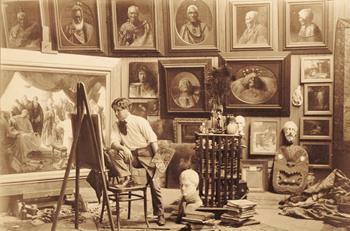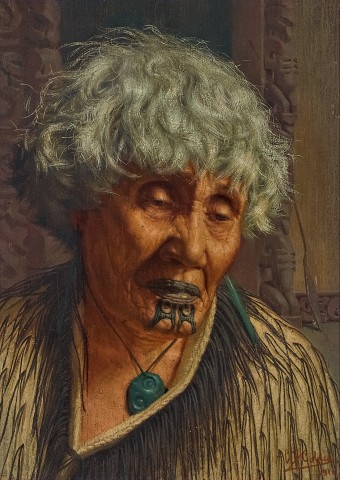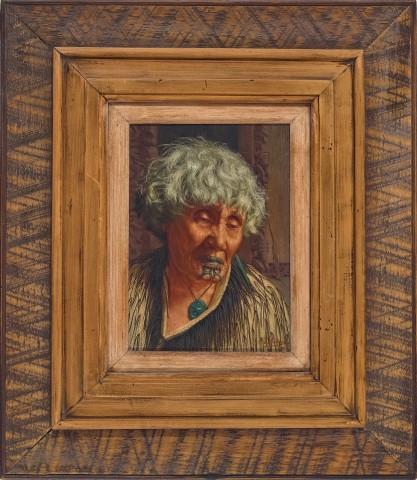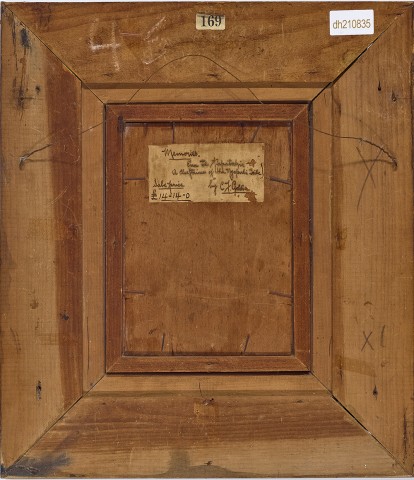MEMORIES, ENA TE PAPATAHI, A CHIEFTAINESS OF THE NGAPUHI TRIBE, 1910
CHARLES FREDERICK GOLDIE
oil on panel
20.5 x 14.5 cm
signed and dated lower right: – C F Goldie. / 1910
inscribed with title on handwritten label attached verso: Memories. / Ena Te Papatahi. / a chieftainess of the Ngapuhi Tribe / by C. F. Goldie.
original artist's frame
Private collection
Leonard Joel, Melbourne, 16 November 1972, lot 169
Private collection, Adelaide
Thence by descent
Private collection, Adelaide
Thirtieth Annual Exhibition, Canterbury Society of Arts, Christchurch, 17 March 1910, cat. 191
Thirty-fourth Annual Exhibition, Auckland Society of Arts, Auckland, 20 - 29 May 1915, cat. 148
The memory of what has been and never more will be [Ina Te Papatahi, Ngã Puhi], 1905, oil on canvas, 115.0 x 90.0 cm, in the collection of the Dunedin Public Art Gallery, Dunedin, New Zealand
Forty Winks, 1915, oil on canvas, 62.5 x 75.5cm, private collection
1567.jpg

Memories: Ena Te Papatahi, 1910, is a fine example of the paintings by Auckland artist Charles Frederick Goldie (1870 – 1947) who specialised in the detailed portrayal of sitters chosen to represent what he called the ‘old Maori who in a very short time will be a thing of the past.’1 Goldie began painting these works on his return to Auckland after four years study in Paris where he attended Julian’s Academy from 1893 until 1898. There he studied under famous academic artists like William Bouguereau from whom he learnt a style of oil painting that involved a high degree of skill in drawing and painting the human figure in a naturalistic way with an emphasis on modelling, and illusionistic texture. It was a studio-based practice requiring the use of posed models and controlled lighting. Detail and verisimilitude were essential so that the close-up view was favoured.
With Goldie, as in Memories, it is almost always a one-on-one encounter with the sitter. We experience the intimacy of being able to almost reach out and touch his subjects, for the tactile is the essence of his art. He had a passionate involvement with his artistic mission and was remarkable for his single-minded focus on one type of work. He painted almost nothing else for his entire career but portraits of old-time Maori. At an early stage of his career, it was remarked how he returned again and again to the same sitters. This was especially true of Ena Te Papatahi who sat for Memories. A critic for The Auckland Star in 1905 remarked that ‘...the well-known chieftainess ... sat for two pictures this year, as well as two the year before and two before that.’2 Undeterred he continued to paint her, even showing her controversially as if in death in The Last Sleep (location unknown). In all, he painted her some twenty times.
The pragmatic reason for her popularity with Goldie was given by the Auckland Star critic as her ready availability. Although Goldie presents her in Memories as seemingly living in a traditional Maori village, she did in fact live in the Waipapa Maori Hostel in Mechanics Bay, Auckland, a short walk from Goldie’s Hobson Street studio. The Hostel was a facility in Auckland where Maori who had difficulty finding accommodation in town could stay for free with their own people. Ena stayed there for years with a friend who also posed for Goldie. Ena was able to go to Goldie’s studio and get regular work for which he paid her. This was exactly the arrangement painters living in Rome or Paris had when hiring exotic models to pose for their compositions. Goldie was not interested in Ena simply as a subject for a portrait. She could be a vehicle for projecting the melancholic mood he wanted to show at the passing of traditional Maori lifestyle and values. Her age, her chin tattoo (moko kauae) and her dignified bearing as a chieftainess matched his requirements. Also, she was willing to pose and to be dressed by the artist, as in this case, in a cloak (korowai) with black tassels, with a tiki carved in greenstone (pounamu) hung around her neck and an ear pendant, also of greenstone, visible on her shoulder. The inclusion of carved Maori figures in the whare (house) behind her and the paddle evoke a traditional setting, not that of urban Auckland.
What Goldie has done is transform Ena into his symbolic image of an old Maori chieftainess lost in recollections of earlier pre-colonial times. The title Memories captures that idea succinctly. In another, larger painting of Ena in the Dunedin Art Gallery the title is expanded to ‘The memory of what has been and never more will be.’ Ena appears to have been a likeable character with a keen sense of humour who wore European dress and smoked a pipe. On occasion Goldie showed her this way. While Goldie did not have great imaginative ability, he did have a commitment to conveying ideas and feelings through the mood of his paintings. At times he could be humorous as well as sad and nostalgic. He was not just a literal recorder of what was before him but an interpreter of the Maori at a time of great change. There is nothing to suggest that he had a deep knowledge of Maori language and culture. He did not speak Te Reo, Maori language, nor did he have engagement with their society. He was in many respects an outsider, but he took his art seriously and captured much of the dignity (mana) of his sitters in his paintings which are prized today by modern Maori as a treasure (taonga) to be handed down to future generations. He painted both male and female sitters favouring those who were older and had the traditional tattoo or moko. He rarely painted young women or young men.
210835.jpg

Memories is an excellent example of Goldie’s smaller works on a wooden panel rather than canvas. It dates to 1910, a time which is regarded as his finest period as a painter. The wood support gave a firm surface for him to build up his textures as seen in the treatment of the grey hair of Ena with heavy impasto to give it a tactile quality. He also evokes the depth of the incisions of her moko, cut by chisel, into the flesh in a painful process. In this instance the painting has a pronounced chiaroscuro in the face with fully half the image in shadow. Ena’s eyes are downcast, and half closed to convey the idea of introversion and thought rather than awareness of or engagement with the viewer. In another work called Forty Winks, 1915 (private collection) he shows Ena asleep in her own dream world. Goldie was an admirer of Rembrandt whose studies of elderly sitters such as his Woman in Prayer, known in various versions, use the same effects of chiaroscuro and self-absorption to convey a mood that leads from the literal to the spiritual. This dimension sets Goldie apart from his most well-known rival in the depiction of Maori, Gottfried Lindauer (1839 – 1926).3 Lindauer made extensive use of photographs and gives a wooden, objective recording of features and artefacts suitable for a museum display. Goldie aims at a more human recording of feeling and gives a greater sense of reality to his portraits by his technical skill and illusionism. For example, the way he shows the tiki half hidden by the cloak gives an informality to the item and does not emphasize its ethnographic value. Although small, Memories bestows a dignity and grandeur to Ena Te Papatahi that befits the subject who was descended from prominent Nga Puhi rangatira (chiefs).
1. Goldie to Alfred Hill, 23 Oct. 1916. Hill Correspondence, vol. 2, pp. 285 – 87, Mitchell Library, Sydney.
2. See Blackley, R., Goldie, Auckland Art Gallery, Auckland, 1997, pp. 22 – 25, with full bibliography.
3. See Gottfried Lindauer’s New Zealand: The Maori Portraits, Auckland Art Gallery, Auckland, 2016.
MICHAEL DUNN
EMERITUS PROFESSOR OF FINE ARTS, UNIVERSITY OF AUCKLAND


